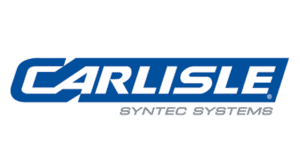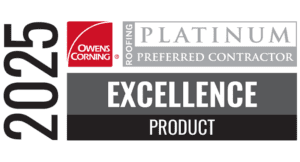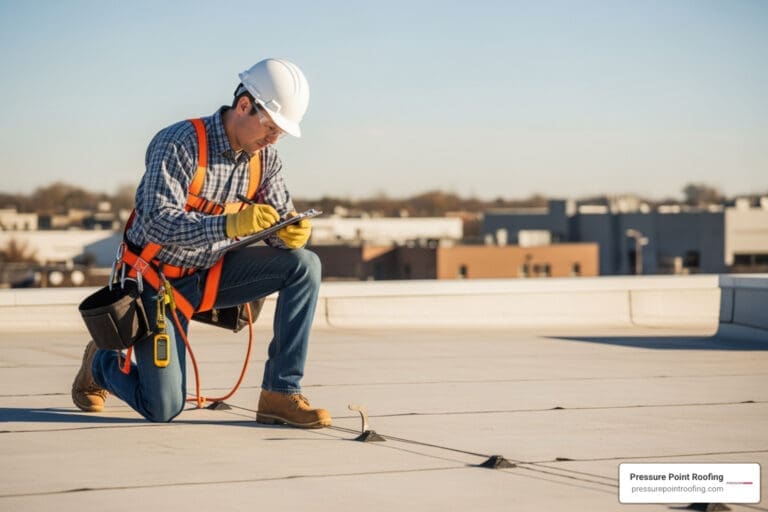Considering Switching from Asphalt Shingles to a Metal Roof?
 When it’s time to replace your roof, you might wonder whether to stick with traditional asphalt shingles or upgrade to a metal roof. While asphalt shingles remain the most common residential roofing material, metal roofing is gaining popularity for its durability, energy efficiency, and modern look. If you’re considering switching from asphalt shingles to a metal roof, here’s what you need to know before making your decision.
When it’s time to replace your roof, you might wonder whether to stick with traditional asphalt shingles or upgrade to a metal roof. While asphalt shingles remain the most common residential roofing material, metal roofing is gaining popularity for its durability, energy efficiency, and modern look. If you’re considering switching from asphalt shingles to a metal roof, here’s what you need to know before making your decision.
Factors to Consider Before Switching from Asphalt Shingles to a Metal Roof on Your Home:
1. Benefits of Metal Roofing
Metal roofing offers several compelling advantages compared to asphalt shingles:
- Durability and Longevity: Metal roofs can last 40–70 years, compared to the 15–30-year lifespan of asphalt shingles. They are resistant to cracking, shrinking, and eroding and can withstand extreme weather, including hail, high winds, and even wildfire embers.
- Energy Efficiency: Metal roofs reflect solar radiant heat, which can reduce cooling costs by up to 25%. Many metal roofing systems also include integral insulation, adding to your home’s thermal efficiency.
- Low Maintenance: Once installed, a metal roof requires very little maintenance. You won’t have to worry about moss, mildew, or frequent repairs as you might with shingles.
- Environmentally Friendly: Metal roofs are often made from recycled materials and are fully recyclable at the end of their life. Additionally, their long lifespan reduces waste compared to more frequently replaced asphalt shingles.
2. Initial Cost vs. Long-Term Investment
At Pressure Point Roofing, we help homeowners analyze the full lifetime cost of a roofing system to make the most informed decision for their property and budget.
- Higher Upfront Cost: Installing a metal roof can cost two to three times more than asphalt shingles. This upfront investment often deters homeowners at first glance.
- Cost Over Time: However, the long-term value of metal roofing can outweigh the initial cost. You’re less likely to need repairs, replacements, or maintenance. Additionally, energy savings and possible insurance discounts (due to the fire and weather resistance) can further offset the expense.
3. Style and Material Options
Modern metal roofing isn’t limited to the industrial-looking panels of the past. There are several aesthetic options to match your home’s style:
- Standing Seam Metal Roofs: These feature vertical panels with seams raised above the roof level. They’re sleek, modern, and highly weather-resistant.
- Metal Shingles or Tiles: If you prefer the look of traditional shingles or even slate or clay tiles, you can choose metal products that mimic these styles while enjoying the benefits of metal.
- Material Choices: Common metal roofing materials include steel (the most common and cost-effective, usually coated for corrosion resistance), aluminum (lightweight and corrosion-resistant, suitable for coastal regions), and copper and zinc (premium options with distinctive looks and exceptional longevity).
4. Considerations for Installation
- Structural Support: Metal roofs are lightweight compared to some other materials, but the structure of your home must be evaluated to ensure it supports the new roofing system and any necessary underlayment.
- Existing Roof Removal: Some metal roofs can be installed over existing shingles, depending on the condition of the old roof and local building codes. However, removing old shingles is often recommended to inspect for hidden issues and ensure optimal installation.
- Ventilation and Insulation Adjustments: Your current roofing system may need changes to ventilation or insulation. Proper attic ventilation is critical for any roofing material, especially when switching to metal, to avoid condensation problems.
- Noise Concerns: Many homeowners worry that metal roofs will be noisier during rain or hail. However, when installed correctly with proper underlayment and attic insulation, metal roofs are no louder than shingles.
5. Performance in Southern Oregon’s Climate
Southern Oregon experiences a range of weather, from hot, dry summers to wet, snowy winters. Metal roofing performs exceptionally well in this region:
- Wildfire Resistance: Non-combustible metal roofs can offer greater protection in fire-prone areas.
- Snow Shedding: Snow slides off metal roofs more easily than asphalt shingles, reducing the risk of ice dams and structural stress.
- Wind and Rain Protection: Properly installed metal roofs withstand high winds and prevent water infiltration even in heavy storms.
At Pressure Point Roofing, we have decades of experience installing roofs that can handle our region’s unique conditions while looking great and lasting for decades.
6. Maintenance and Repairs
- Fewer Repairs: Metal roofing is less prone to damage that affects shingles, such as curling, blistering, or missing tabs. However, maintenance is still important, especially around penetrations, flashing, and fasteners.
- Regular Inspections: We recommend a professional inspection every few years to ensure all components are secure and sealed. Keeping gutters clean and trimming overhanging branches also helps extend the roof’s lifespan.
- Paint and Finish Maintenance: Most metal roofs are coated with a paint finish that protects against UV and corrosion. Over time, this finish may fade or chalk. Re-coating can restore appearance and protection.
7. HOA and Building Code Considerations
Before installing a metal roof, homeowners should check with their homeowners association (HOA) and local building department:
- HOA Guidelines: Some HOAs restrict roofing materials or require approval for style and color changes.
- Building Codes: Certain local codes may dictate how the roof is installed, particularly regarding fire ratings or wind uplift resistance.
Our team at Pressure Point Roofing ensures all projects are code-compliant and helps homeowners navigate any permitting or approval processes.
8. Choosing the Right Contractor
Not all contractors have the experience or skills necessary for proper metal roof installation. It’s essential to choose a qualified roofer who:
- Is licensed, bonded, and insured.
- Has experience specifically with metal roofing systems.
- Offers detailed estimates and clearly explains options.
- Uses high-quality materials backed by strong manufacturer warranties.
- Has a reputation for excellence, with local references and reviews.
At Pressure Point Roofing, our team is trained in asphalt and metal roofing systems. We provide homeowners with transparent recommendations based on their goals, budget, and long-term plans for their home.
Is Metal Roofing Right for You?
Switching from asphalt shingles to a metal roof is a significant investment that can offer superior durability, energy savings, and curb appeal. It’s ideal for homeowners looking for a long-lasting, low-maintenance roofing system that can withstand Southern Oregon’s demanding weather conditions.
If you’re considering this upgrade, consult with our expert team at Pressure Point Roofing. We’ll assess your existing roof, review your options, and help you decide whether a metal roof is the right solution for your home. Visit Pressure Point Roofing today to schedule a free estimate and learn more about roofing options to protect your home.
Schedule a Consultation
By submitting this form, I agree to receive calls and text messages (including those sent using automated technology) from Pressure Point Roofing, LLC and its representatives at the number provided. Message and data rates may apply. Message frequency may vary. Consent is not required as a condition of purchase. Reply STOP to unsubscribe at any time.
Related Content
Partners and Awards












